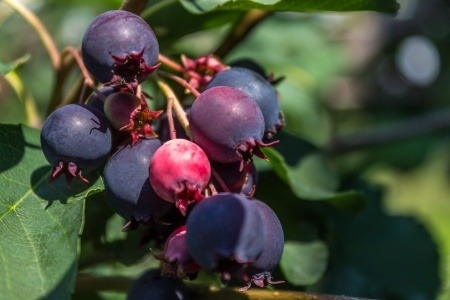
It sounds like we’ve just entered Saskatchewan in Canada when we talk of Saskatoon but it’s the berry we are keen on, not the region. I know it looks like a blueberry and frankly if you were offered one then you would say a saskatoon was a poor substitute when it comes to taste but don’t dismiss it – its flavour works well with other fruits. To most people the flavour is very much like a blueberry crossed with a cherry, with a hint of almond.
Saskatoons are probably the new superfood and should be treated as such. The one big difference between them and blueberries is they don’t need acidic soils for good growth. Given the limey soils of the Forest of Dean, blueberries can only really be grown in large pots otherwise the Saskatoon sounds like a good bet for more open growth in the leafy garden where it grows amongst open heathland.
The fruit comes from the Amelanchier alnifolia but its more common names include alder-leaf shadbush, dwarf shadbush, the Western Juneberry and the Pacific Serviceberry. It used to be called Pigeon Berry but that has fallen largely out of fashion.
The plant is found throughout much of the USA and Canada where it grows at high elevations in places like the Rockies. It grows up to 8 metres and is deciduous. The flowers are white and beckon us over to inspect them more closely. The fruit looks like a large blueberry or a small bullace or damson fruit and is almost as purple in colour.
Can be used to form a dense, but productive hedge !
Cultivation
Saskatoons thrive in any good, well-drained, moisture retentive soil and will tolerate alkaline conditions up to a pH of 7.5.
Soil conditions: prepare the soil by digging in plenty of well-rotted manure or compost. The rootball on planting needs to be thoroughly moist, so stand it in a bucket of water for 30 mins. beforehand and then plant. The plants need to be set slightly deeper in the soil than they would be if still in the pot. Gently firm the roots with the heel of the show. Staking isn’t required unless a howling gale rips through the garden. They are reliable to grow and need a good feed each Spring for the crop to come.
I would grow it as a bush, pruned to form a good shape and make it easy to pick the fruit. In fact, when the bush is first planted, leave it to grow simply to put on as much growth as possible. It’s ripening season is from June to August as we move inland. The best flavour comes just before the fruit becomes overripe and without bruising it.
The main nutritious qualities are richness in polyphenols such as anthocyanins, some minerals including calcium, magnesium and manganese so it could rival birch sap for that latter property.
We have used them in jams and as a fruit sauce but I prefer it in combination with strawberries and raspberries. The taste is slightly bitter due to the polyphenols but that hints at its goodness. Some say it tastes like a cherry with hint of almond and actually works well in granola when the fruit is dried. Use in pies and salad dressings for something slightly different.
Cultivars
The bush is not readily available but we hear that Frank P Matthews will offer some cultivars in the near future from their garden centres. The cultivars are ‘Thiessen’ and ‘Martin’ which ripen first, followed by Smokey, Northline and JB30. Incidentally the leaves look fiery red in the Autumn so it keeps it’s powerful colouring long after the fruit has been eaten.
cv. Smoky – A very heavy cropping variety that is both hardy and reliable. Produces a mass of striking white flowers in spring followed by extremely sweet and juicy, medium to large blue/purple fruits around six weeks later. This variety will reach a maximum height and spread of approximately 3-4m (9-13ft.), but this can be kept down if required.
The plant is self fertile and does not need a pollination partner, although fruiting may be improved if it is grown with another variety of Saskatoon. Usually supplied 2ft high in a 3 litre pot.
<
p style=”text-align: center;”>
Leave a Reply